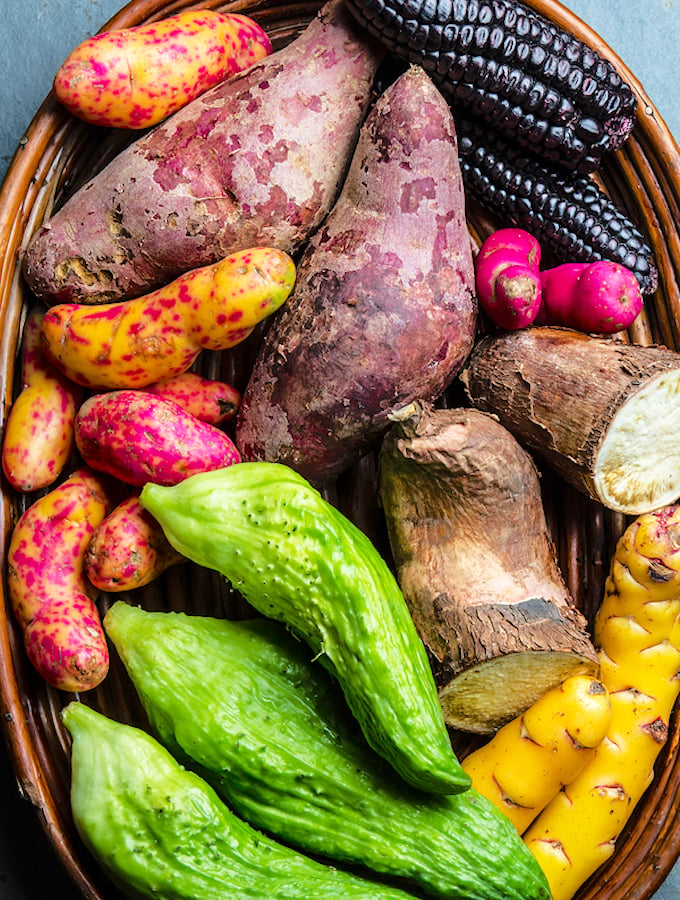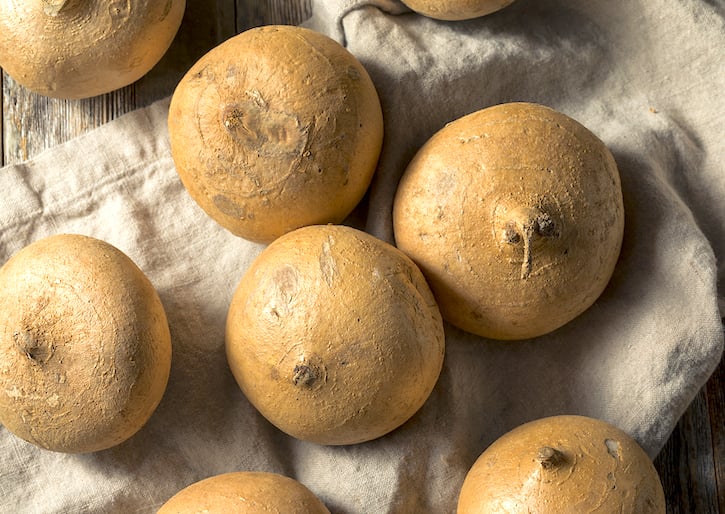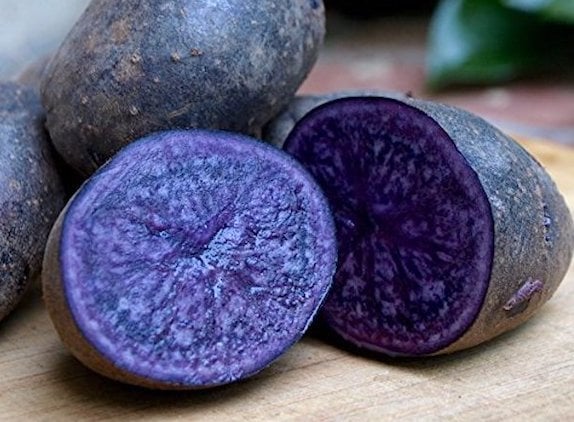Here are 11 Caribbean and Latin American vegetables to look for on your next shopping trip or order online. If you’re bored with the same old-same old, you might like to explore some vegetables that might be exotic to us, but which are mainstays in the cuisines of Latin and South America, as well as the Caribbean.

Many vegetables native to the warm climates of Latin America and the Caribbean islands differ greatly from the usual lettuce, tomatoes, corn, etc. common to North American grocery stores and farm markets.
Farmers keep vegetable gardens growing all year-round in warm-climate areas of the Caribbean and Latin America. This allows for an extended growing season and warm soil which increases germination.

Many are roots and tubers
Roots and tubers are quite common in these locations and are considered tropical vegetables. They require adequate moisture and drainage to grow. In addition to being super flavorful, they’re rich in vitamins, minerals, and carbohydrates, which gives consumers a huge inexpensive source of dietary energy.
There’s currently an abundance of Caribbean and Latin American vegetables that are available in the United States. The following list includes Caribbean and Latin American vegetables most likely to find in your local supermarket.
But if you find they aren’t available near you, there’s an abundance of global produce on these sites:
And if you want to delve even more deeply into Latin and South American vegetables, explore Dominican Tubers.
Caigua
Caigua, or cyclanthera pedate, is a tropical herbaceous vine plant native to South America. Although the vine is known for its small fruit, countries especially in the Andes region think of it as a cucumber and call it by other names, such as achojcha and slipper gourd.
Caigua is a well-loved vegetable, not only for its delicious cucumber-green bean taste but also for its nutrients. Peruvians especially value caigua, and it’s considered one of the most powerful and natural fat absorbers.
There are very few calories in caigua, so if you’re looking for diet-friendly foods, this is the vegetable for you! There are many ways to enjoy it. Traditionally it’s hollowed out and stuffed, but you can used it steamed, baked, and even in soups. It’s a good ingredient to use in a simple stir fry like this one.

Callaloo
Callaloo, also known as Chinese spinach or Indian Kale, is a leafy green, spinach-like vegetable that originated in West Africa and is served in various islands across the Caribbean, especially Jamaica and Trinidad. Callaloo — both the vegetable and variations of the dish of the same name that features it, have a long history in the Caribbean islands, first emerging in the 1600s.
Callaloo grows on the amaranth plant, an extremely prolific crop, which is why many consider it a superfood. Although it may look like spinach, callaloo has a rather different taste. It’s slightly bitter with a nutty undertone that many people love. Not to mention that it’s packed with vitamins A, B, and C, and is high in fiber, iron, potassium, and calcium.
An easy way to prepare it: Remove any dead leaves and hard stalks, then rinse it well. Boil a large pot of salted water and boil the callaloo for 5 to 10 minutes, until tender. This leafy vegetable can also be eaten raw as part of salads and such; make sure to rinse very well to remove all grit!
Recipes:
Chayote
Chayote, also named mirliton and choko, is a green variety of squash that’s a member of the gourd family, Cucurbitaceae. In the era of the Columbian Exchange, chayote was one of the many foods introduced to the Old World. Soon after, it spread to other parts of the Americas, where it became part of Latin American cuisine.
Chayote has a mild flavor, similar to cucumber, and a not-so-tender edible skin that should be discarded before eating. When cooked, chayote can be handled as you would any other squash.
You may also eat the vegetable raw by cutting it up and adding it to salsas or salad with a hint of lime juice. Regardless of how you choose to eat it, you’ll still be soaking up all of its amazing vitamin C.
Recipes:

Jícama
This potato-like vegetable is a root with a subtly sweet taste and a papery golden-brown skin with a starchy white interior. Jicama is native to Mexico but has made its way into other warm areas, such as Puerto Rico, Hawaii, and the southwest United States.
Raw jicama tastes like a cross between raw potato and water chestnut, though a bit juicier and sweeter. It’s a fantastic vegetable to incorporate into dishes that need a bit more flavor and texture, including all kinds of salads — even fruit salad. If you’re looking for a more exotic french fry, try making jicama fries on the stovetop or in a hot oven, much as you would prepare other roasted vegetables.
Recipes:

Oca
Oca, sometimes referred to as the “lost crop of the Incas,” is a vibrant, slightly tangier alternative to the common potato. This vegetable is a perennial tuber native to South America, and can now also be found growing in the Pacific Northwest.
Raw or lightly cooked, oca is crunchy, with a firm, juicy, and crisp flesh. Rinse well and slice them to add a hint of lemony flavor to your favorite salads. In Mexico, oca is often eaten raw, drizzling slices with a bit of salt and lemon juice.
The vegetable becomes more starchy the longer it’s cooked, and begins to soften, similar to the flesh of a boiled potato. That’s the traditional way in which the indigenous people of the Andes mountains like to prepare it. If you want to enjoy oca in a similar way, simply slice thickly and add to stews and soups.
Recipes:

Peruvian Purple Potato
These beautiful deep purple potatoes are native to Peru and Bolivia. They made their way to Europe in the 16th century via Spanish sailors gathering the vegetable for their long voyages. Today, they’re grown and consumed all over South America, North America, and Europe.
Peruvian purple potatoes may look very different compared to a white potato, but in reality, they taste similar. One big difference between the two is that purple potatoes contain two to three times the antioxidants of white or yellow potatoes which stave off risks of chronic disease.
Since the only difference between these potatoes and regular potatoes is their color, simply prepare them the way you would any other potato. My personal favorite is a tri-color potato and arugula salad, linked to, below.
Recipes:

Taro Root
Taro root is a starchy, Asian-cultivated root vegetable. The root has brown outer skin and white flesh with scattered purple specks throughout and is native to Southeast Asia and India. Over the years, it has become a staple in the diets of that region and has been widely adopted in the Caribbean.
Taro has a pleasantly sweet and nutty taste that resembles a sweet potato. It has subtle hints of vanilla with a floral taste as well, making it a popular flavor in Asia for bubble tea, ice cream, and halo-halo, a popular Filipino cold dessert. In addition to its lovely taste, taro root may be able to help control blood sugar and aid in weight loss.
Indulge in the versatile taro root at home by boiling and mashing, sautéing, or roasting.
Recipes:

Ulluco
Ulluco, similar to oca, is a tuber crop native to the Andean region of South America. It is one of the most widely grown and economically important root crops in South America, making it second to the potato.
It has a firmer texture than potato and comes in a variety of vibrant colors — fuchsia, orange, yellow, and green. Its taste can be described as a combination of beet and potato with subtle buttery and nutty notes. Don’t discard the leaves! The leaves of the ulluco plant are edible as well and can be used like spinach.
Ulluco can be eaten raw or cooked, cooked is the most common. Most people love ulluco because, similar to jicama, its crisp texture remains even after being cooked due to its high water content. Boil or fry ulluco and enjoy it as a side dish!

Yacón
Yacón, also called the Peruvian ground apple, is a root extracted from the yacón plant, a sunflower relative from the highlands. Native to the Andes mountains in South America, it’s now grown in the Pacific Northwest as well.
The root has a crisp, sweet taste, similar to jícama. Yacón can even have a floral undertone, reminiscent of violet. In addition to eating the flesh, an amber-colored syrup can be extracted from the root and used as a mouth-watering, low-calorie sweetener.
There are many ways to prepare yacón — stewed, grated in a slaw, cubed, added to salads, and more. If you’re craving something savory, add it in salads or sauces. If you’re in the mood for something sweet, think of it as a mild apple, bite in, and enjoy!
Recipes:

Yam
Yam is a tuber native to Africa. As of 1999, there were more than 600 varieties, 95% of which are grown in their native land, Africa. Now, you can find them growing in most temperate and tropical regions, including Latin and South America.
Yams are not to be mistaken for sweet potatoes, as the two aren’t even distantly related. The skin of a yam somewhat resembles tree bark, while sweet potato has a smoother, reddish-brown skin.
Compared with sweet potatoes, yams are drier, starchier, and not as sweet, with a flavor that can easily be altered depending on cooking method.
Despite their differences, yams can be prepared in the familiar ways in which potatoes and sweet potatoes are used. They’re excellent in soups and stews, where they can absorb other flavors. No matter how you prepare them, yams will give you lots of fiber, potassium, and other nutrients.
Recipes:

Yucca
Yucca, also known as cassava, tapioca root, manioc, etc., is a root vegetable. It grows in subtropical climates, such as South America, Mexico, and the Caribbean Islands, its native homeland.
Yucca root looks visibly similar to sweet potato on the outside and has a mild, sweet, and almost nutty flavor with a creamy, white, and grainy texture, almost similar to potatoes. Though they may seem similar, one big difference between the two is that yucca contains more calories, protein, and carbs, making it ideal for athletic and active individuals.
If you’re interested in preparing yucca the same way that Caribbeans and Latin Americans enjoy this luscious root vegetable, boil and pair it with a garlic sauce or fry it to make yucca fries.
Recipes:
See more of this site’s Good Food Guides
. . . . . . . . .
Skyler Isabella Gomez is a 2019 SUNY New Paltz graduate with a degree in Public Relations and a minor in Black Studies. Her passions include learning about the ethical and environmental benefits of veganism to create a better world for generations to come.
All photos: Bigstock



Thank you so much for publishing this article Skyler! I’m exploring new foods and this is very helpful 😄
Hi Dee — sorry I missed your comment and took so long to approve it. Skyler wrote many helpful articles for The Vegan Atlas a few years ago, and has gone on to other adventures.